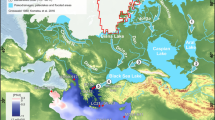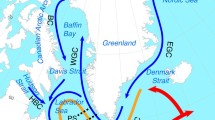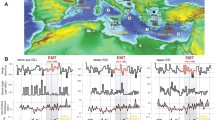Abstract
Sediment cores from the Mediterranean Sea have evidenced several periods of Sapropel deposition, which can be explained by events of anoxic bottom conditions. An explanation for such events calls for a very stratified sea, possibly related with freshwater input through increased precipitations and runoff discharges. It has been suggested that such a stratified Mediterranean Sea may in turn weaken the Atlantic meridional overturning circulation (AMOC) through changes in the Mediterranean overflow water (MOW). Nevertheless, models used to establish this result were relatively simple and the mechanisms leading to such an impact remained elusive. To improve on those previous studies, we analyse the impact of different freshwater releases with rates of 0.2, 0.1, 0.05 and 0.02 Sv (1 Sv = 106 m3/s) in the Mediterranean Sea using the IPSL-CM5A-LR model in a few multi-centennial simulations. We focus the analysis on the impact of a decrease in the MOW on the large-scale Atlantic circulation. We find a consistent change in horizontal currents in the upper Atlantic Ocean in all simulations in the first century, with a large enhancement of the northward current west of Rockall in the northeast Atlantic. Concerning the AMOC response, we identify three different processes that impact its fate. The first is related to changes in geostrophic currents at depth induced by the disappearance of the MOW, which tends to weaken the AMOC. On the contrary, the second enhances the AMOC and is associated with the increase in northward currents in the horizontal upper circulation. The last process is due to the spread of surface freshwater anomalies out of the Mediterranean Sea that freshens the North Atlantic convection sites and weakens the AMOC. Depending on the rate of the freshwater release, the strength and balance of these three processes are different. For rates larger than 0.05 Sv, we observe a strong reduction of the AMOC, while for lower rates, we notice an enhancement in the upper cell. The climatic response follows that of the upper AMOC with a warming of the North Atlantic for rates lower than 0.05 Sv and a cooling for higher rates. Given that past estimates of freshwater release in the Mediterranean Sea indicate rates lower than 0.05 Sv, we argue that Sapropel events may have enhanced of the upper AMOC and warmed of the North Atlantic.















Similar content being viewed by others
References
Algan O, Çağatay N, Tchepalyga A et al (2001) Geo-Mar Lett 20:209. https://doi.org/10.1007/s003670000058
Andersson A et al (2010) The hamburg ocean atmosphere parameters and fluxes from satellite data—HOAPS-3. Earth Syst Sci Data Discuss 3(1):143–194. http://www.earth-syst-sci-data-discuss.net/3/143/2010/
Aumont O, Bopp L (2006) Globalizing results from ocean in situ iron fertilization studies. Global Biogeochem Cycles 20(2):GB2017. https://doi.org/10.1029/2005GB002591
Bahr A et al (2014) Deciphering bottom current velocity and paleoclimate signals from contourite deposits in the Gulf of Cádiz during the last 140 kyr: an inorganic geochemical approach. Geochem Geophys Geosyst 15(8):3145–3160
Bahr A et al (2015) Persistent monsoonal forcing of mediterranean outflow water dynamics during the late Pleistocene. Geology 43(11):951–954
Beckmann A, Döscher R (1997) A method for improved representation of dense water spreading over topography in geopotential-coordinate models. J Phys Oceanogr 27(4):581–591. https://doi.org/10.1175/1520-0485(1997)027%3C0581:AMFIRO%3E2.0.CO%5Cn2
Bigg GR, Wadley MR (2001) Millennial-scale variability in the oceans: an ocean modelling view. J Quat Sci 16(4):309–319
Blaschek M et al (2015) Holocene North Atlantic overturning in an atmosphere-ocean-sea ice model compared to proxy-based reconstructions. Paleoceanography 30(11):1503–1524
Böning CW et al (1995) Deep water formation and meridional overturning in a high-resolution model of the North Atlantic. J Phys Oceanogr 26:1142–1164
Born A, Stocker TF, Sandø AB (2016) Transport of salt and freshwater in the Atlantic Subpolar Gyre. Ocean Dyn 66:1051–1064
Bosmans JHC et al (2012) Monsoonal response to mid-holocene orbital forcing in a high resolution GCM. Clim Past 8(2):723–740
Bosmans JHC et al (2015) Precession and obliquity forcing of the freshwater budget over the Mediterranean. Quat Sci Rev 123:16–30. https://doi.org/10.1016/j.quascirev.2015.06.008
Bozec A et al (2011) On the variability of the mediterranean outflow water in the North Atlantic from 1948 to 2006. J Geophys Res 116:C09033. https://doi.org/10.1029/2011jc007191
Bryden HL, Kinder TH (1991) Steady two-layer exchange through the Strait of Gibraltar. Deep Sea Res Part A Oceanogr Res Pap 38:S445–S463
Chan W-L, Motoi T (2003) Effects of stopping the Mediterranean outflow on the southern polar region. Polar Meteorol Glaciol 17:25–35. http://ci.nii.ac.jp/naid/110000034872/en/
Colin C et al (2010) Neodymium isotopic composition of deep-sea corals from the NE Atlantic: implications for past hydrological changes during the Holocene. Quat Sci Rev 29(19–20):2509–2517
Cramp A, O’Sullivan G (1999) Neogene sapropels in the Mediterranean: a review. Mar Geol 153(1–4):11–28
Criado-Aldeanueva F, Soto-Navarro FJ, García-Lafuente J (2012) Seasonal and interannual variability of surface heat and freshwater fluxes in the Mediterranean Sea: budgets and exchange through the Strait of Gibraltar. Int J Climatol 32(2):286–302
Dufresne JL et al (2013) Climate change projections using the IPSL-CM5 Earth System Model: from CMIP3 to CMIP5. Clim Dyn 40(9–10):2123–2165
Ehrmann W et al (2007) Clay minerals in late glacial and Holocene sediments of the northern and southern Aegean Sea. Palaeogeogr Palaeoclimatol Palaeoecol 249(1–2):36–57
Escudier R, Mignot J, Swingedouw D (2013) A 20-year coupled ocean-sea ice-atmosphere variability mode in the North Atlantic in an AOGCM. Clim Dyn 40(3–4):619–636
Fichefet T, Morales Maqueda AM (1997) Sensitivity of a global sea ice model to the treatment of ice thermodynamics and dynamics. J Geophys Res 102:2609–2612
Grant KM et al (2016) The timing of Mediterranean sapropel deposition relative to insolation, sea-level and African monsoon changes. Quat Sci Rev 140:125–141. https://doi.org/10.1016/j.quascirev.2016.03.026
Grimm R et al (2015) Late glacial initiation of Holocene eastern Mediterranean sapropel formation. Nat Commun 6:7099. http://www.nature.com/doifinder/10.1038/ncomms8099
Hillaire-Marcel C et al (2001) Absence of deep-water formation in the Labrador Sea during the last interglacial period. Nature 410(6832):1073–1077
Holliday NP et al (2008) Reversal of the 1960s to 1990s freshening trend in the northeast North Atlantic and Nordic Seas. Geophys Res Lett 35(3):1–5
Hourdin F et al (2006) The LMDZ4 general circulation model: climate performance and sensitivity to parametrized physics with emphasis on tropical convection. Clim Dyn 27(7–8):787–813
IPCC (2013) Climate Change 2013: The Physical Science Basis. Contribution of Working Group I to the Fifth Assessment Report of the Intergovernmental Panel on Climate Change [Stocker, T.F., D. Qin, G.-K. Plattner, M. Tignor, S.K. Allen, J. Boschung, A. Nauels, Y. Xia, V. Bex and P.M. Midgley (eds.)]. Cambridge University Press, Cambridge, p 1535
Ivanovic RF et al (2013) The parameterisation of Mediterranean-Atlantic water exchange in the Hadley Centre model HadCM3, and its effect on modelled North Atlantic climate. Ocean Model 62:11–16
Ivanovic RF et al (2014) Sensitivity of modern climate to the presence, strength and salinity of Mediterranean-Atlantic exchange in a global general circulation model. Clim Dyn 42(3–4):859–877
Jackson LC et al (2015) Global and European climate impacts of a slowdown of the AMOC in a high resolution GCM. Clim Dyn 45(11–12):3299–3316
Jia Y (2000) Formation of an Azores Current due to Mediterranean overflow in a modeling study of the North Atlantic. J Phys Oceanogr 30:2342–2358. http://ams.allenpress.com/amsonline/?request=get-abstract&issn=1520-0485&volume=030&issue=09&page=2342
Jordà G et al (2017) The Mediterranean Sea heat and mass budgets: estimates, uncertainties and perspectives. Prog Oceanogr 156(July):174–208
Kallel N et al (1997) Enhanced rainfall in the Mediterranean region during the last Sapropel Event. Oceanol Acta 20(5):697–712
Kissel C et al (2013) Variations in the strength of the North Atlantic bottom water during Holocene. Earth Planet Sci Lett 369–370:248–259. https://doi.org/10.1016/j.epsl.2013.03.042
Lascaratos A et al (1999) Recent changes in deep water formation and spreading in the eastern Mediterranean Sea: a review. Prog Oceanogr 44:5–36
Levitus S (1982) Climatological atlas of the world ocean. Professional paper 13, NOAA/GFDL
Lourens LJ (2004) Revised tuning of Ocean Drilling Program Site 964 and KC01B (Mediterranean) and implications for the δ18O, tephra, calcareous nannofossil, and geomagnetic reversal chronologies of the past 1.1 Myr. Paleoceanography 19(3):1–20
Lozier MS, Stewart NM (2008) On the temporally varying northward penetration of mediterranean overflow water and eastward penetration of Labrador Sea water. J Phys Oceanogr 38(9):2097–2103. https://doi.org/10.1175/2008JPO3908.1
Ludwig W et al (2009) River discharge of water and nutrients to the Mediterranean and Black Sea: major drivers for ecosystem changes during past and future decades? Prog Oceanogr 80:199–217
Madec G et al (1991) A three-dimensional numerical study of deep-water formation in the northwestern Mediterranean Sea. J Phys Oceanogr 21(9):1349–1371. http://cat.inist.fr/?aModele=afficheN&cpsidt=5149571
Madec G (2008) NEMO ocean engine. Institut Pierre-Simon Laplace (IPSL), Paris
McCartney MS, Mauritzen C (2001) On the origin of the warm inflow to the Nordic Seas. Prog Oceanogr 51(1):125–214
Mercone D et al (2000) Duration of S1, the most recent sapropel in the eastern Mediterranean Sea, as indicated by accelerator mass spectrometry radiocarbon and geochemical evidence. Paleoceanography 15(3):336–347
Millot C, Taupier-Letage I (2005) Additional evidence of LIW entrainment across the Algerian subbasin by mesoscale eddies and not by a permanent westward flow. Prog Oceanogr 66:231–250
New AL et al (2001) On the role of the Azores Current in the ventilation of the North Atlantic Ocean. Prog Oceanogr 48(2–3):163–194
Özgökmen TM, Crisciani F (2001) On the dynamics of β plumes. J Phys Oceanogr 31(12):3569–3580. http://www.scopus.com/inward/record.url?eid=2-s2.0-0035713465&partnerID=tZOtx3y1
Patton H, Hubbard A, Andreassen K, Auriac A, Whitehouse PL, Stroeven A, Shackleton C, Winsborrow M, Heyman J, Hall A (2017) Deglaciation of the Eurasian ice sheet complex. Quat Sci Rev 169:148–172
Penaud A et al (2010) Contrasting paleoceanographic conditions off Morocco during Heinrich events (1 and 2) and the Last Glacial Maximum. Quat Sci Rev 29:1923–1939
Penaud A et al (2011) Assessment of sea surface temperature changes in the Gulf of Cadiz during the last 30 ka: implications for glacial changes in the regional hydrography. Biogeosciences 8:2295–2316
Rahmstorf S (1998) Influence of mediterranean outflow on climate. Eos Trans AGU 79:281
Reid JL (1979) On the contribution of the Mediterranean Sea outflow to the Norwegian-Greenland Sea. Deep Sea Res Part A Oceanogr Res Pap 26(11):1199–1223
Reid JL, Mantyla AW (1978) On the mid-depth circulation of the North Pacific Ocean. J Phys Oceanogr 8(8):946–951
Revel M et al (2010) 100,000 years of African monsoon variability recorded in sediments of the Nile margin. Quat Sci Rev 29(11–12):1342–1362. https://doi.org/10.1016/j.quascirev.2010.02.006
Rogerson M et al (2005) Glacial to interglacial changes in the settling depth of the Mediterranean outflow plume. Paleoceanography 20(3):1–12
Rogerson M et al (2010) Enhanced Mediterranean-Atlantic exchange during Atlantic freshening phases. Geochem Geophys Geosyst 11(8):Q08013
Rogerson M, Rohlin EJ, Weaver PPE (2006) Promotion of meridional overturning by Mediterranean-derived salt during the last deglaciation. Paleoceanography 21(4):1–8
Rohling EJ, Marino G, Grant KM (2015) Mediterranean climate and oceanography, and the periodic development of anoxic events (sapropels). Earth Sci Rev 143:62–97. https://doi.org/10.1016/j.earscirev.2015.01.008
Rossignol-Strick M et al (1982a) After the deluge: mediterranean stagnation and sapropel formation. Nature 295(5845):105–110
Rossignol-Strick M et al (1982b) After the deluge: mediterranean stagnation and sapropel formation. Nature 295:105–110
Roullet G, Madec G (2000) Salt conservation, free surface, and varying levels: a new formulation for ocean general circulation models. J Geophys Res Oceans 105:23927–23942
Saba VS et al (2015) Enhanced warming of the Northwest Atlantic Ocean under climate change. J Geophys Res Oceans 120:118–132
Schönfeld J, Zahn R (2000) Late Glacial to Holocene history of the Mediterranean outflow. Evidence from benthic foraminiferal assemblages and stable isotopes at the Portuguese margin. Palaeogeogr Palaeoclimatol Palaeoecol 159:85–111
Simmons AJ et al (2007) ERA-Interim: new ECMWF reanalysis products from 1989 onwards. ECMWF Newsl 110:25–36
Soto-Navarro J et al (2010) Estimation of the Atlantic inflow through the Strait of Gibraltar from climatological and in situ data. J Geophys Res 115:C10023. https://doi.org/10.1029/2010jc006302
Soto-Navarro J et al (2015) Evaluation of regional ocean circulation models for the Mediterranean Sea at the Strait of Gibraltar: volume transport and thermohaline properties of the outflow. Clim Dyn 44(5–6):1277–1292
Swingedouw D et al (2009) Impact of freshwater release in the north Atlantic under different climate conditions in an OAGCM. J Clim 22(23):6377–6403
Tailleux R, Rouleau L (2010) The effect of mechanical stirring on horizontal convection. Tellus Ser A Dyn Meteorol Oceanogr 62(2):138–153
Thornalley DJR, Elderfield H, McCave IN (2009) Holocene oscillations in temperature and salinity of the surface subpolar North Atlantic. Nature 457(7230):711–714. https://doi.org/10.1038/nature07717
Thunell RC, Williams DF (1989) Glacial-Holocene salinity changes in the Mediterranean Sea: hydrographic and depositional effects. Nature 338:493–496
Tierney JE, Pausata FSR, de Menocal PB (2017) Rainfall regimes of the Green Sahara. Sci Adv 3(1):e1601503. https://doi.org/10.1126/sciadv.1601503
Toucanne S et al (2007) Contourites of the Gulf of Cadiz: a high-resolution record of the paleocirculation of the Mediterranean outflow water during the last 50,000 years. Palaeogeogr Palaeoclimatol Palaeoecol 246:354–366
Toucanne S et al (2015) Tracking rainfall in the northern Mediterranean borderlands during sapropel deposition. Quat Sci Rev 129:178–195
Tudryn A et al (2016) The Ponto-Caspian basin as a final trap for southeastern Scandinavian Ice-Sheet meltwater. Quat Sci Rev 148:29–43. https://doi.org/10.1016/j.quascirev.2016.06.019
Vidal L et al (2010) Hydrology in the Sea of Marmara during the last 23 ka: implications for timing of Black Sea connections and sapropel deposition. Paleoceanography 25(1):1–16
Voelker AHL et al (2006) Mediterranean outflow strengthening during northern hemisphere coolings: a salt source for the glacial Atlantic? Earth Planet Sci Lett 245(1–2):39–55
Wu W, Danabasoglu G, Large WG (2007) On the effects of parameterized Mediterranean overflow on North Atlantic Ocean circulation and climate. Ocean Model 19:31–52
Wüst G (1961) On the vertical circulation of the Mediterranean Sea. J Geophys Res 66(10):3261–3271. https://doi.org/10.1029/JZ066i010p03261
Zhao Y, Colin C, Liu Z, Paterne M, Siani G, Xie X (2012) Reconstructing precipitation changes in northeastern Africa during the Quaternary by clay mineralogical and geochemical investigations of Nile deep-sea fan sediments. Quat Sci Rev 57(4):58–70
Acknowledgements
We thank Eleanor Georgiadis for very significant help in the language improvement of this paper, Julie Deshayes for enlightening discussion concerning the parametrization used in the NEMO model, Jonathan Beuvier for useful discussions on the present-day Mediterranean circulation and Olivier Marti for well-thought insights concerning the way to perform sensitivity experiments. The research leading to this study has received funding from the French National Research Agency HAMOC project (Grant ANR-13-BS06-0003). This work was granted access to the HPC resources of TGCC under the allocation No. 2016-017403. We thank Patrick Brockmann for help with figure design. This research also benefited from Blue-Action project (European Union’s Horizon 2020 research and innovation program, Grant Number: 727852).
Author information
Authors and Affiliations
Corresponding author
Additional information
Publisher's Note
Springer Nature remains neutral with regard to jurisdictional claims in published maps and institutional affiliations.
Rights and permissions
About this article
Cite this article
Swingedouw, D., Colin, C., Eynaud, F. et al. Impact of freshwater release in the Mediterranean Sea on the North Atlantic climate. Clim Dyn 53, 3893–3915 (2019). https://doi.org/10.1007/s00382-019-04758-5
Received:
Accepted:
Published:
Issue Date:
DOI: https://doi.org/10.1007/s00382-019-04758-5




